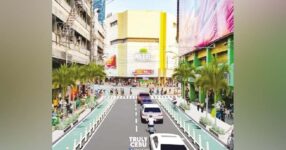
Use of CBRT’s excess funds questioned
EXCESS money from the implementation of the first package of the Cebu Bus Rapid Transit (CBRT) is being used to fund the pedestrianization project in downtown Cebu City.
This was revealed by City Councilor Jocelyn Pesquera in an interview with SunStar Cebu’s online news and commentary program “Beyond the Headlines” on Monday, July 1, 2024,
Pesquera pointed out that the money came from a loan whose purpose did not include the pedestrianization project.
She encouraged the public to file a case before the Omdudsman, but she did not specify what case it would be.
According to atg.com, pedestrianization refers to the process of removing or limiting vehicular traffic to prioritize the access of pedestrians to public areas.
She said the pedestrianization project will encroach on portions of Osmeña Blvd., which stretches all the way from the Plaza Independencia in the east to the Capitol building in the west.
“V. Rama is only up to Taboan, not reaching the sea. Gorordo Ave. is only up to General Maxilom. That’s (Osmeña Blvd.) the only road nga naka-east to west nya pagkahuman imong gub-on just because sobra ang kwarta sa CBRT (and you will destroy portions of the only road that stretches east to west because you have excess money from the CBRT)?” Pesquera said.
“What kind of mindset do they have that just because there is money they’ll use it all up? That is why some people start to question, ‘Why are they pushing?’ Why is it necessary to spend?’” she said in a mix of Cebuano and English.
The local legislator said the pedestrianization project did not factor in the country’s climate, which can get really hot and humid during the summer and wet during the rainy season.
Unlike in other countries abroad where residents take advantage of the fair weather by taking a stroll on wide pedestrianized streets, she said.
“Our roads are already small and with the pedestrianization these will even be made smaller,” she said in Cebuano.
Pesquera also said the roads in Cebu City are substandard and do not meet the minimum standards of the agreed-upon road width.
“The standard width is 3.25 meters per lane, but here it’s 2.75 meters,” she said in Cebuano.
Meanwhile, the city councilor reminded government officials that before coming up with a program, they should be considerate of other stakeholders.
She said alternatives roads must be provided where vehicles can pass before pedestrianizing an area.
She said changing routes, particularly of public utility vehicles, requires a lot of processes, including submitting the proposal to the City Council. The council will have to pass an ordinance and public hearing will have to be conducted.
“Taas pa kaayo nag proseso usa ta makaimplementar (It’s a very long process because the project can be implemented),” Pesqerua said.
However, she acknowledged that the City Planning and Development Office already has a plan, which it has yet to submit to the council.
Pesquera recalled the lamppost incident in the downtown area. These were installed without the necessary permits, which resulted in these being taken down upon orders of Acting Mayor Raymond Alvin Garcia.
“And then the CBRT management even sent a request for permission to council and that’s why we called an executive session to discuss for them to present their plan and we were surprised that they were still asking for permission, but they already installed the posts then they also conducted some excavations. And with the smallness of the road, it has become even small still,” she said in a mix of English and Cebuano.
According to a previous SunStar Cebu report, the lampposts were part of the link-to-port component of the CBRT project.
CBRT project manager Norvin Imbong previously said he received Garcia’s approval for the project. However, Garcia clarified that although he gave the go-ahead, the CBRT management still needed to obtain the required clearances, which included approval from the council for the road closure, a permit from the Department of Engineering and Public Works for the excavation and clearance from the traffic office for the new route.
SunStar Cebu tried to reach Imbong to ask for clarifications on the pedestrianization project, but to no avail.
In a separate phone interview on June 23, 2024, City Councilor Jerry Guardo said that the Department of Transportation, the CBRT proponent, was obtaining the required permits for the lampposts.
The first package of the CBRT project, which covers a distance of 2.38 kilometers from the Cebu South Bus Terminal along N. Bacalso Ave. to the front of the Capitol building along Osmeña Blvd. is worth a little over a billion pesos (P1.048 billion). / JPS



